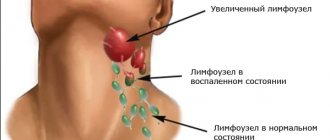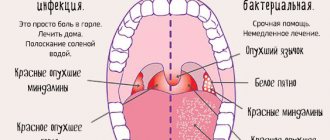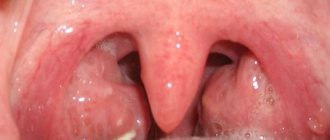Treatment
For the purpose of treatment, symptomatic and etiotropic drugs are used.
Therapy will depend on the causative disease. The choice of remedies is made by the doctor after research and identification of the main factor of pain in the ears when swallowing. Treatment may include the following:
- tablets, drops, ointments;
- physiotherapeutic procedures;
- folk remedies;
- surgical intervention.
Medication
Drug therapy may include antibacterial drugs, antiviral, antiseptic, vitamin, and anti-inflammatory drugs. For bacterial infections and purulent processes, antibiotics are always indicated. For this purpose, ear drops Anauran and Sofradex are used.
For pain relief in children and adults for any pathology, non-steroidal anti-inflammatory drugs are used - Nurofen, Paracetamol, Ibuprofen. They can be prescribed in the form of tablets, syrups and rectal suppositories, depending on the age of the patient.
For viral infections, antiviral drops are indicated - Garazon, Otofa, Normax, Cipropharm. They have a complex effect, simultaneously eliminating the inflammatory process and relieving pain.
Physiotherapeutic
UHF ear (painless procedure).
Physiotherapeutic procedures are used to treat otitis and other inflammatory diseases of the ENT organs. They have general contraindications - low blood pressure, pathologies of the hematopoietic organs, fever, oncology, disorders of the cardiovascular system.
The doctor may prescribe the following procedures:
- UHF - about 5 procedures lasting up to 7 minutes are performed;
- electrophoresis - a solution of zinc sulfate and antibiotics are used;
- microwave therapy - exposure to an electromagnetic field for 5 minutes;
- ultraviolet irradiation - warming up takes about 15 minutes.
Traditional methods
Use traditional methods only after consulting a doctor!
After consulting with your doctor, you can use some folk remedies for pain relief. These can be solutions, compresses, applications.
At home you can use the following techniques:
- aloe juice for instillation into the ear;
- alcohol tinctures for compresses;
- warming the ear with warm salt wrapped in gauze.
To provide first aid for acute pain in the ear when swallowing, you should take a painkiller tablet and immediately go to the doctor. Self-medication with folk remedies is contraindicated, as there is a risk of complications.
Otitis externa
With this type of disease, damage occurs to the auricle and external auditory canal. Ear pain with otitis externa is the main symptom. The main cause of discomfort is considered to be a bacterial infection. This type of illness is very rare.
Ear pain may increase when talking, chewing, or swallowing. The ears feel full, and there is redness and swelling of the ear canal. The temperature may rise to 37.5 °C. If the inflammation has spread to the eardrum, discharge may begin from the ear opening. Headache often occurs.
Otitis externa is treated with antibiotics prescribed by a doctor. To reduce swelling, the doctor prescribes allergy medications (antihistamines). Nonsteroidal anti-inflammatory drugs (Aspirin, Diclofenac, Ketoprofen, Ibuprofen) help reduce pain. The specialist prescribes vitamins or dietary supplements to strengthen the immune system.
Therapy
Treatment tactics are chosen individually, depending on the examination results.
To eliminate a sore throat at home, you can gargle with Furacilin solution. Stir 1 tablet of the product in a glass of hot water.
To get rid of headaches in inflammatory diseases, it is better to use NSAIDs rather than simple analgesics; the most effective is Paracetamol.
It not only relieves headaches, but also lowers temperature. But remember that it is not advisable to lower the temperature below 38 degrees.
You will learn more about the treatment of inflammatory processes in the throat in the video:
Diagnostics
If you have a sore throat, you should contact your local physician or ENT specialist.
Diagnosis of throat diseases is carried out according to the following scheme:
- Questioning the patient about the nature of the pain, after which it appeared, whether it is accompanied by other symptoms:
- soreness;
- wet or dry cough;
- runny nose;
- elevated temperature;
- ear pain.
- Internal inspection. Using a pharyngoscope, the doctor examines the upper palate, the mucous membrane of the pharynx, and tonsils. This evaluates:
- throat color;
- presence of edema;
- the presence of plaque on the mucous membrane and tonsils;
- the presence of ulcers and spots.
- In case of purulent inflammation, in addition to general urine and blood tests, a smear from the larynx is performed for bacteriological culture.
Causes
There are a number of pathologies in which similar symptoms occur. Other symptoms help determine what a person is sick with.
In children, similar symptoms occur with chickenpox, measles, and scarlet fever. These diseases are rarely diagnosed in adults.
Tubootitis can cause pathology. This is an inflammatory process in the mucous membranes of the eardrum and eustachian tube. The patient notes tinnitus, decreased hearing acuity, and a slight increase in temperature. When you move your head, you feel like water is pouring in your ears.
Another disease that causes unpleasant symptoms is eustachitis. Inflammation occurs in the Eustachian tube. Most often there is no temperature. Soreness occurs due to the fact that the inflamed tissues, which have increased in size, compress nearby organs.
Angina
With a sore throat, the tonsils and throat become inflamed. A characteristic symptom is a strong increase in body temperature. However, most patients do not have a runny nose. A white or light yellow coating appears on the surface of the larynx. Patients report bad breath. Weakness appears, the patient quickly gets tired. Swallowing is painful and difficult.
The pain may radiate into the ears due to the accumulation of pus. This symptom does not always occur; it often appears when treatment is delayed. The localization of pain in the throat can also be different: sensations can be localized on the left, right, or in the middle.
Pharyngitis
Pharyngitis is an inflammatory process in the pharynx. This disease is characterized by dryness of the pharyngeal mucosa, sore throat, and dry cough. Sore throat, raw, scratching; spread to the ear area. There is swelling, hyperemia of the palatine arches and the posterior wall of the inflamed organ. The cervical, occipital and submandibular lymph nodes become larger in size, and pain appears on palpation.
There is general weakness, high fatigue, and headaches. Fever and chills are possible. Localization may vary. Often discomfort occurs only on the right or only on the left side.
Otitis
This inflammatory process affects the inner ear. There is a pain in the throat area that radiates to the ear, the intensity of which increases in the evening and reaches a peak at night. Body temperature rises, fever and chills occur. Appetite disappears, weakness occurs. If the pus ruptures the eardrum and leaks out, the shooting sensation in the ear becomes less intense.
The disease often turns out to be a complication of a cold that is not completely cured.
Laryngitis
If you have a sore throat, a person may have laryngitis, an inflammatory process that affects the mucous membrane of the larynx. A barking cough appears. Gradually it turns into wet, the sputum released contains inclusions of blood. The size of the submandibular lymph nodes increases; palpating them is unpleasant and painful. Swallowing is difficult and speaking also becomes difficult.
As the inflammatory process progresses, other symptoms arise. The patient's body temperature rises to 37-40 degrees, and a lump is felt in the throat. If swelling is present, the person will feel difficulty breathing. Nasal congestion, weakness, and pain in the muscles appear.
Lymphadenitis
A sore throat can also appear due to inflammation of the lymph nodes. This pathology is manifested by an increase in damaged structures, pain when palpating, high body temperature, drowsiness, headaches, and weakness. Advanced stages are characterized by changes in the skin: the skin turns red and swelling occurs. Local temperatures are 1-2 degrees higher than in undamaged areas. If the disease was caused by the penetration of pathogenic bacteria, the lymph nodes will fester and become dense.
Sinusitis
When the mucous membrane of the paranasal sinuses becomes inflamed, heaviness in the nasal area, thick discharge from it, and high temperature appear. It hurts when moving the head. Adults often develop a cough, runny nose, and discomfort in the throat.
Causes of ear pain
The main reasons that cause pain in the ear when swallowing include the following.
Otitis
The most common ear disease. It is customary to distinguish between external, middle and internal otitis. Each has its own symptoms, but in all cases, inflammation and swelling of varying degrees occurs in the ear.
When swallowing saliva, the pressure on the eardrum and auditory tube increases for a while, causing sharp pain. Most often, otitis occurs against the background of ARVI or influenza. Also, water or foreign objects entering the ear can cause a similar condition.
Laryngitis, sinusitis and tonsillitis
Diseases of the throat, larynx and nose are in second place among the main causes. During illness, the development of microbes and bacteria occurs, the body intensively secretes secretions, which provoke the formation of mucus. Thanks to this mucus, foreign organisms (bacteria) are removed from the nasal cavity or throat.
This defensive reaction is very effective. However, in some cases, mucus can get into the ear area, causing inflammation there and, as a result, otitis media. In addition, the muscles of the pharynx are attached to the auditory tube; if they are inflamed, then when they reflexively contract from swallowing, the pain will move to the ear area.
Mumps
In common parlance, mumps is an infectious disease caused by paramyxovirus, affecting the nervous system and glandular organs. With this disease, the submandibular and salivary glands located near the ears are primarily affected.
As a result, dry mouth and swelling around the glands are observed. The disease mainly affects children, and it is especially dangerous for boys, since it affects the genitals and leads to loss of reproductive ability. Mumps is spread by airborne droplets and household contact. It is the one that is primarily suspected when children complain of pain in the ear when swallowing.
Lymph nodes
Lymph nodes are natural barriers to infections and viruses that make it difficult for them to pass through to spread throughout the body. Lymph nodes can become inflamed for a number of reasons:
- ARVI and sore throat;
- oncology;
- problems with the thyroid gland;
- fungal diseases;
- AIDS and HIV;
- vitamin deficiency, reduced immunity.
More often than others, it is the submandibular and postauricular lymph nodes that are affected. Due to their inflammation, you feel discomfort and pain when you swallow saliva or food.
The location of the lymph nodes in the neck explains the localization of discomfort
Toothache
Ear pain is closely related to teeth. As a rule, discomfort occurs as the last molars or eights grow. Due to the fact that during the process of evolution the jaw was somehow deformed and reduced in size, there was simply no room left in the dentition for the last teeth.
As a result, they have to literally fight their way out, while they often grow incorrectly and disturb neighboring teeth. Inflammation almost always occurs as they grow; sometimes a cyst, pus, or gum pockets form. The pain that accompanies all this radiates to the ear.
Trigeminal nerve
The situation is dangerous when the trigeminal facial nerve is affected. It originates in the brain and branches along the lower jaw, under the eyes and above the eyebrows. With hypothermia, mechanical damage or herpes, any part of this nerve can become inflamed. In this case, the person experiences sharp and severe pain in the facial area.
Since the trigeminal nerve is responsible for the functions of biting, chewing and swallowing, when performing these simple movements, pain occurs that radiates to the ear. If it hurts to swallow and radiates into the ear, this may be a consequence of barotrauma, when ear pressure changes when flying at altitude or diving to depth.
Provoking factors
The throat, nose, and ears hurt badly due to various diseases of the ENT organs. This malaise may be accompanied by fever, general weakness and enlarged lymph nodes. Most often, sore throat and ear congestion occur with:
With otitis media, not only the ear but also the throat always hurts at the same time. Generally, the pain intensifies in the evening. When the disease is severely advanced, pus leaks from the ear.
A sore throat can also cause a sore throat and ear pain. In this case, the lymph nodes become inflamed, the pain radiates not only to the ears, but also to the jaw and temples. With angina, in the first days of the illness, severe headache is observed.
The cause of the discomfort may be sinusitis. When the maxillary sinuses become inflamed, the face and nose area hurt greatly, and the pain radiates to the temples and ears. A combination of symptoms is always observed: nasal congestion, high fever and severe weakness.
Severe hypothermia can lead to soreness in the throat and ears. This often happens after a person gets his feet wet. In this case, immunity decreases and uncontrolled proliferation of bacteria begins, which are constantly present in the nasopharynx of every person.
Throat diseases in which pain radiates to the ear
Most often, pain radiates to the ear with the following diseases.
Lymphadenitis
Lymphadenitis is characterized by the presence of an inflammatory process in the tissues of the lymph nodes. In most cases, the cause of the development of pathology is a bacterial or viral infection. Sometimes lymphadenitis is caused by exposure to toxic substances. Damage to the lymph nodes in the neck and ears leads to severe pain that radiates to the ear.
Pharyngitis
Pharyngitis is inflammation of the pharynx. Pathology can develop due to infection, and also be non-infectious in nature. Additional symptoms of infection include watery eyes and a feeling of nasal congestion. Non-infectious pharyngitis can occur due to hypothermia during inhalation of cold air. In addition, the pathology can be caused by inhalation of toxic vapors or prolonged contact with substances that provoke irritation of the mucous membrane. The pain associated with the disease is dull in nature, but radiates to the ears.
Tonsillitis
Tonsillitis (tonsillitis) is inflammation of the tonsils. The disease is always accompanied by pain in the throat and ears, but the pain first appears in the throat. The cause of the disease is bacteria, viruses or fungi. Pathogenic organisms multiply on the tonsils and cause inflammation. Sore throat with sore throat can be acute, radiating to the ear. In a chronic process, nagging pain occurs. With angina, the temperature very often rises above 38º. Very often, a burning sensation and soreness occurs in the throat, which leads to a reflex cough.
Rhinitis
Rhinitis is characterized by inflammation of the nasal mucosa. This is manifested by the appearance of a runny nose. In the initial stage of the disease, shooting pains in the ear may be observed. In severe cases, hearing may be impaired. The cause of the disease is usually a viral infection. The risk of developing rhinitis increases during colds and seasonal epidemics.
Sinusitis
Sinusitis is an inflammation of the paranasal sinuses. The causes of the pathological process are associated with bacterial, viral or fungal infection. Pathogenic organisms multiply and infect the upper respiratory tract. Very often the disease occurs as a complication after tonsillitis or pharyngitis. The pathology provokes an increase in body temperature and can cause pain in the ear.
Otitis
Otitis is characterized by the presence of inflammation in various parts of the ear. The disease can occur in acute or chronic form. Pain syndrome is accompanied by a significant deterioration in a person’s well-being. Otitis can occur simultaneously with a sore throat or pharyngitis, as a result of which the patient suffers from pain in both the throat and ear.
Treatment
By using frequent gargles in the initial stage of the disease if your throat hurts, and applying heat to the ear on the painful side, you can avoid exacerbations and complications.
For a prolonged illness, the doctor may prescribe complex treatment:
- antibiotics: Amoxicillin, Ampicillin, Bicillin-5,
- in severe forms of the disease - cephalosporins: Ceftriaxone or Cefadroxil,
- macrolides: Summed or Erythromycin,
- antiseptics (Chlorhexine) and immunomodulators (Galavit),
- combined drugs: Stopangin or Strepsils, if the throat and ear hurt on one side, inside and outside,
- antihistamines, for example, Diphenhydramine or Suprastin,
- throat sprays: Kameton, Stopangin, Hexethidine.
To prevent the pain from getting worse, you should adhere to bed rest and avoid drafts. The infection will go away, and one-sided pain involving the throat, jaw and ear will subside when applying heat from a “blue lamp”, applying vodka or alcohol compresses, instilling boric alcohol or camphor oil in the ear, rinsing the nose with warm water with the addition of sea salt . At the same time, you should not go outside to prevent hypothermia of the painful area.
Important. If your ear and throat hurt on one side and radiates to your jaw, you should not drink cold water, sparkling water, alcohol, or eat solid foods or foods that irritate your throat.
This will aggravate the disease, returning cough and inflammation of the mucous membrane.
Inflammation and pain go away from warm tea with a spoon of honey and a slice of lemon, from fortified decoctions of medicinal salicylates to strengthen the immune system.
Phlegm, mucus and microorganisms always circulate freely in the system from the ears, throat and nose. During the inflammatory process, shooting pain always radiates from the throat or nose to the ears, jaw and vice versa.
Useful video about the manifestations of serious ENT diseases
Disease prevention
To avoid the occurrence of pathology, it is recommended to carry out preventive measures on a regular basis.
Immunity should be strengthened. Hardening, daily exercises, and taking vitamins with food or in the form of special complexes will help with this. It is recommended to give up bad habits: smoking, alcohol, consuming various substances that are toxic to the body. Healthy sleep and sufficient rest time are important. It is necessary to walk in the fresh air. To prevent pathological conditions, you can drink herbal decoctions in courses. It is recommended to consult a doctor to select appropriate medicinal plants.
During the cold season, the head and neck should not be allowed to become hypothermic. It should be remembered that you can get sick not only in winter, but also in summer. During the hot season, you should not drink too many cold drinks or consume excessive amounts of ice cream and fruit ice. During epidemics, public places should be avoided. It is recommended to spend as little time as possible in large stores, public transport and other locations where infection is likely to occur. To reduce the risk, you need to wear a special face mask
It is important to change it promptly: if you wear a mask for too long, it will cease to be an effective means of protection against infection.
It is important to wash your hands with soap. Unwashed hands are especially dangerous after visiting a hospital, where there are often a large number of infected people.
Any illness should be treated promptly. Often dangerous diseases arise due to a cold that is not completely cured. Complications can also be caused by other pathologies.
When the first symptoms appear, you should consult a therapist. This will help avoid the development of the pathological process and facilitate treatment.
source
Possible complications
If you experience unilateral pain in the throat and ear, you should consult a doctor. Incorrectly selected or self-prescribed treatment can not only aggravate the course of the disease, but also cause serious complications.
For example, tonsillitis has a negative effect on the functioning of the heart. Therefore, prolonged and frequent sore throats in most cases lead to heart problems. And a disease like scarlet fever negatively affects the joints. And of course, many acute diseases become chronic. You can learn about exacerbation of chronic tonsillitis in this material.
A dangerous complication is the spread of infection to the lungs. With diphtheria, heart complications are possible. Some diseases become chronic and difficult to treat. Hearing may deteriorate to the point of complete loss.
How to treat
To reduce pain, you can take a pain reliever and consult a doctor immediately. The doctor will examine the ear and prescribe ear drops or advise how to cope with the problem using home remedies. An examination by an otolaryngologist is also mandatory for the reason that only a doctor can determine whether pus has accumulated in the ear. In this case, warming compresses and drops are contraindicated.
In case of otitis externa, when the skin of the external auditory canal becomes inflamed, anti-inflammatory therapy (ointments, drops), including those containing antibiotics, is prescribed. Pharyngitis or tonsillitis is treated with antibiotics. They should also be prescribed by a doctor.
For otitis media in the initial stage, the doctor will recommend warm compresses and ear drops, including those with an analgesic effect.
Why does my throat and ear hurt?
If it hurts you to swallow and your ears hurt, most likely an inflammatory process is developing in the body, which affects the ENT organs.
Colds, ARVI and flu are not a complete list of diseases that cause such symptoms.
Main diseases causing pain
Diseases that cause pain in the ears and throat:
- Otitis is an inflammation affecting the outer, middle or inner ear (labyrinthitis). With otitis media, the ears not only become blocked, but also a sharp shooting pain appears; as the inflammatory process spreads, it radiates to the head and throat. Other symptoms also occur: hearing loss, discharge of serous or purulent exudate from the ears, and increased body temperature.
- Rhinitis is an inflammatory process occurring in the nasal cavity. With rhinitis, the nasal mucosa swells, mucus accumulates in the cavities, in which microbes develop. Inflammation can spread to the nasopharynx and ears, so pain occurs on one side or on both sides. When you have a runny nose, it becomes difficult to breathe; the brain does not receive enough oxygen, which causes headaches.
- Sore throat - acute tonsillitis is an inflammation of the tonsils and pharynx; with the disease, a purulent process often occurs that spreads deeper. Sore throat provokes severe pain in the throat. Patients have a sore throat when swallowing and radiate into the ear, body temperature rises, and severe headaches occur. Sore throat can also be recognized by bad breath, chills, and tinnitus.
- Laryngitis is an inflammation of the mucous membrane of the larynx; it is not an independent disease; it occurs against the background of hypothermia or other diseases - measles, whooping cough, scarlet fever and others. The inflammatory process can spread to the ears. Also, with laryngitis, redness of the pharyngeal mucosa, dry cough, and fever occur.
- Pharyngitis is an inflammation of the mucous membrane and lymphoid tissue of the pharynx. Pharyngitis occurs when inhaling cold or hot air, as well as when the body is infected with pathogenic microorganisms. With pharyngitis, the patient not only has a sore throat, but also a dry cough, enlarged lymph nodes in the neck, and an increase in body temperature. The patient experiences muscle and joint pain.
The causes of pain in the throat and ears lie not only in ENT diseases. More serious pathologies can also cause these unpleasant symptoms.
Possible diseases causing pain
Other diseases that cause pain in the throat and ears:
- Chickenpox is chickenpox or a type of herpes zoster, an acute viral disease. With chickenpox, the body temperature rises and red rashes appear on the skin. Against the background of a weakened immune system, laryngitis may appear, hence a sore throat that develops into earaches and headaches.
- Diphtheria is an infectious disease that affects the oropharynx. With diphtheria, severe intoxication of the body occurs, the body temperature rises, a white coating appears on the tonsils, and it becomes painful for the patient to swallow. The clinical picture is complemented by general malaise, headaches and ear pains, and enlarged lymph nodes.
- Measles is an acute infectious viral disease with a temperature rise of up to 40 degrees. With measles, the mucous membranes of the mouth and larynx become inflamed, a rash appears on the skin, conjunctivitis, dry cough, ear pain and headache occur.
- Scarlet fever is an infectious disease caused by group A streptococcus. The patient develops a severe fever and a rash appears on the body. The main symptom of scarlet fever is sore throat. Secondary tonsillitis provokes a sore throat. Ear pain and headaches occur against the background of general intoxication of the body.
- Whooping cough is an acute bacterial infection that causes a severe, spasmodic cough. The clinical picture is complemented by general intoxication of the body, increased body temperature, ear and headache, and runny nose.
- A retropharyngeal abscess is a purulent inflammation of the tissue in the retropharyngeal space. When the disease occurs, the temperature rises to 39-40 degrees, severe pain in the throat occurs, which intensifies when swallowing, pain spreads to the head and ears, and nasal breathing becomes difficult. Attacks of suffocation and hoarseness of the voice are often observed.
- Meningitis is an inflammation of the lining of the brain. Depending on the location of the inflammatory process, pain occurs on the left or right side. The patient's temperature rises, accompanied by severe headaches that can radiate to the ear. A sore throat occurs due to a weakened immune system, which cannot fully resist pathogenic microorganisms.
Nose or throat infections
Infections in the nose or throat may cause ear pain when swallowing
While ear infections are the most common cause of ear pain when swallowing, infections in the nose or throat can also cause this symptom.
Small patches of immune tissue called adenoids sometimes grow in response to microorganisms in the nose and mouth.
Adenoids are located near the Eustachian tubes. The Eustachian tubes are the canals that connect the middle ear to the upper throat and nasal cavity. If the adenoids grow too large, they can block the Eustachian tubes and cause pain. This condition is more often observed in childhood, when the adenoids are largest.
Symptoms of nose and throat infections
Symptoms observed with throat and nose infections include the following:
sore throat that gets worse when swallowing;
- cough;
- dry throat;
- redness at the back of the mouth;
- bad breath;
- swelling of the glands in the neck.
Treatment
Features of therapy depend on the diagnosed disease. Most often, several methods are used simultaneously.
The patient is recommended to follow a gentle diet. There should be not too little food, but not too much. It is recommended to eat simple meals that do not burden the digestive system.
Food should be warm. Hard, spicy foods are prohibited. In addition, you should not eat unusual foods, since the reaction to them in a weakened body can be unpredictable.
Drinking plenty of fluids is also recommended. It is allowed to drink drinking water at room temperature, teas, and various decoctions. The patient should drink at least 2 liters of water per day. The liquid will speed up the removal of harmful bacteria from the body.
Drug therapy
Only the attending physician can prescribe medications, dosages, regimen and duration of use.
If the cause of pain is an inflammatory process, the doctor will prescribe anti-inflammatory drugs. In addition, antibiotics are often prescribed, since in a large number of cases inflammation is caused by pathogenic microbes entering the patient's body.
Medicines are also used to relieve the severity of symptoms. Nasal rinses and antipyretics are used.
Gargling with antiseptic solutions is used. It is recommended to repeat this procedure several times a day. The pain becomes less pronounced, regeneration accelerates, and pathogenic microorganisms are removed from the damaged organ. You need to gargle for 5-7 minutes.
Treatment with folk remedies
Traditional medicine methods can be combined with a set of medications prescribed by a doctor. It is not recommended to replace medications with them: this will make the recovery process longer and the treatment will become less effective.
To select recipes, it is recommended to consult a specialist.
Rinsing with calendula decoction helps. Chamomile, eucalyptus, and sage will help get rid of inflammation. You can gargle with solutions of table salt and baking soda.
Warming up
It is recommended to warm your throat with various drinks: hot tea, decoctions of medicinal plants. The liquid will warm the body from the inside. Rinsing with a warm solution will also work. It is recommended to alternate the compositions: since their effects on the body are different, sequential replacement will help achieve a greater effect.
Before using heat for treatment, you should consult a specialist. This method can be harmful to the body, since during heating it creates a favorable environment for the proliferation of pathogenic microorganisms. For angina, this method of treatment is allowed only in the initial stages of the disease.
Compress
Compresses on the throat can be dry or wet. Using wet ones is more effective.
Alcohol compress is recommended for the treatment of adults. To make it, a gauze bandage folded several times is moistened in alcohol or vodka. After this, the fabric is wrung out, applied to the throat and wrapped with a warm scarf on top. An adult can leave the fabric on for 8 hours. If such a compress is given to a child, it should not be kept for more than 3 hours.
A softer curd compress will also help get rid of the pain. To make it, take cottage cheese and liquid honey in a ratio of 1 tsp. honey per 50 g of cottage cheese, heated to body temperature. The products are mixed, wrapped in a gauze bandage and placed on the throat. For fixation, use a warm scarf. You can leave this compress on all night.











